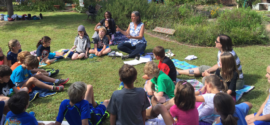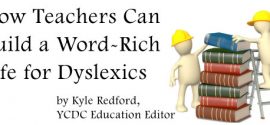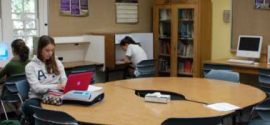Dyslexia and Civil Rights: Making Room on the Bus for All Children
By Wanda M. Holland Greene, Head of The Hamlin School, San Francisco, California
As an African-American educator and school leader who came of age during the 1970s, I am well acquainted with and inspired by the chapters and verse of the Civil Rights Movement. Even as a young child, I remember thinking deeply about people being excluded and rendered invisible because of who they were, and I wondered about the meaning of liberty and the possibility of justice for all. My school bus ride between my black and Hispanic neighborhood in Brooklyn and my all-white elementary school in Queens was a daily reminder of the geographical and psychological boundaries that kept people ensconced in their zones of fear and ignorance, and I decided then that my life’s work would focus on leveling those walls and the playing field, too.
Those early experiences have become my bridge to understanding dyslexia and the plight of students whose strengths go unnoticed in the classroom. When I consider the struggles and marginalization of many dyslexic children and their families, the passionate activists and allies who are pushing for school reform, and the shared vision for a more inclusive and innovative world, it seems natural to reframe dyslexia as a civil rights issue.
Research shows that one in five students is dyslexic. Obviously, some are more severely dyslexic than others, and some go through school without proper diagnosis. When a child’s learning profile is baffling and beyond the scope of the classroom teacher’s expertise (an issue that I will return to), then formal testing is an appropriate course of action. What makes the critical difference between helpful testing that empowers children and harmful testing that marginalizes them is the conclusion we draw from the data. Too often, testing is mistakenly interpreted as a sign that something is broken, terribly wrong, and dysfunctional. The language of telephone calls, parent conferences, and report cards begins to focus on what a child cannot do rather than his or her unique strengths. The implied and explicit message is that the child is no longer considered smart or successful. It does not have to be this way. I have witnessed first-hand the liberation, pride, and excitement that become part of a child’s life at school when an evaluation provides insights into how the child’s brain functions, along with a set of reasonable accommodations and strategies to support instruction.
Indeed, while dyslexic children have trouble getting to the individual sounds of spoken words, leading to spelling difficulties and slower reading, they are also highly intelligent, adaptable, creative, and tenacious in the classroom. The impressive roster of successful adult dyslexics is further proof that the world is shaped by all kinds of brains. Shifting the current educational paradigm about fixing learning disabilities to a conversation about accommodating and celebrating true diversity in the classroom would be revolutionary.
Speaking of revolutions, the quest for equality has always required collective energy and effort. Just as whites marched with blacks, and men became champions for women’s rights, people without dyslexia will need to link arms with those who are dyslexic. Becoming an ally for children—getting on the proverbial bus—means learning as much as we can about the biological basis of dyslexia and its impact. It’s also about recognizing dyslexia as early as possible, identifying it, and providing children with effective interventions while at the same time celebrating their strengths. Being a drum major for justice means educators, employers, and legislators working tirelessly to eradicate old mindsets about who can succeed.
Teachers, in particular, have a large role to play in leveling the playing field by understanding the root causes of dyslexia and not letting it become a label or liability. All heads of school need to prioritize increasing teachers’ capacities to meet the needs of a diverse group of learners. In some cases, this will mean a reallocation of funds for professional development as well as creating time for teachers to collaborate and discuss teaching and learning goals. When teachers acquire new knowledge and refine their pedagogical skills, they will be more adept in designing learning environments that are dynamic, flexible, and fertile for student growth. (See how one school created a dyslexia-friendly environment.)
Of course, some of the “old-school” knowledge and best practices still work. Recommitting to direct instruction in phonics, decoding, spelling, and writing; integrating assistive technology; and using formative and summative assessments to monitor growth and drive instruction will increase the levels of engagement and achievement for ALL students. Of course, parents will need to educate themselves, trust their instincts about their own children, and respect teachers’ insights as well. Students will be the direct beneficiaries when parents and teachers join in open dialogue and courageous action.
Ultimately, dyslexia will not be reframed as a civil rights issue until two fundamental truths are evident: First, there must be an unshakable belief in the importance and power of heterogeneous communities. I believe wholeheartedly that brain differences are a gift and that diversity is a component of excellence. Creative minds can solve some of the world’s greatest problems.
The second truth that must be evident in order for justice to roll down like water is a willingness to recognize unearned privilege. Ultimately, the majority of the population was not negatively affected by the development of the printing press and the proliferation of books in the 1400s; those people were unwittingly granted power to navigate reading, spelling, and writing with ease. On the other hand, a smaller subset of the population whose brains were not wired in that way did not become fluid readers, struggled mightily in school, doubted their self-worth, and often disappointed their parents and teachers. We all lose human capital when dyslexic children’s creativity is stifled and when they are made to feel less valuable than others. It’s time to disrupt the practices that have left some children on the curb and create seats for all on the bus.
Wanda M. Holland Greene is Head of School at The Hamlin School in San Francisco. She is a proud New Yorker and a graduate of Columbia College, receiving her B.A. in English and Psychology. She earned her M.A. in the Department of Curriculum and Teaching from Teachers College, Columbia University. Wanda complements her work as an educator by serving independent schools and nonprofit organizations as a trustee. She is a vocal performer (jazz, gospel, and soul), an avid reader, poet, and writer.
Related

Case Study – How Morningside Elementary School Helps Dyslexic Students Succeed
Teacher training and a well-stocked toolbox help dyslexic students succeed at one Atlanta public school.
Read More
Building a word-rich life for Dyslexics
A confession: I get a significant thrill from reading research that confirms my personal suspicions.
Read More
How speech-to-text transformed a student’s 5th grade year
Last fall, the fifth graders in my class were the lucky recipients of iPads–one for each student.
Read More
Rand Center: A Commitment to Accommodations
“Dyslexia robs a person of time; accommodations return it.” Dr. Sally Shaywitz
Read More